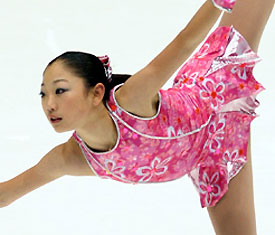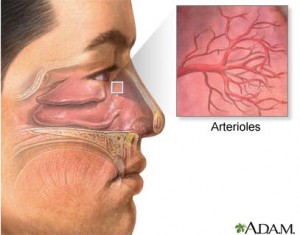American Olympic hopeful left bleeding on the ice

American Olympic figure skating hopeful Mirai Nagasu, left more than her spirit on the ice in last night’s woman’s Short Program. The 16 year old from Arcadia, Calif., says she was plagued by a nosebleed midway through her program. Nagasu told People magazine,”I’ve been having nose bleeds here frequently. I think it is a little bit drier than California, so I’ve been putting saline nose spray in my nose.” The nose bleed apparently didn’t hamper her performance too much, as Nagasu still finished in sixth position, just behind teammate Rachel Flatt.
Nose bleeds, epistaxis in medical jargon, are very common. It is estimated that one in every seven people will have a nosebleed sometime in their life. They can occur at any time, but seem to be more common in children between 2-10 yrs. old and adults over 50.
Most nosebleeds come from the nasal septum in the front of the nose. Just under the surface of the mucosal lining of the nose are many tiny blood vessels called arterioles. Air moving through the nose can dry and irritate the nasal lining, forming crusts. These crusts bleed when irritated by rubbing, picking, or blowing the nose. The lining of the nose is more likely to become dry and irritated from low humidity, allergies, colds, or sinusitis. This is why nosebleeds occur more frequently in the winter, when viruses are common and heated indoor air dries out the nostrils.
Contrary to popular belief, most nosebleeds are not serious and can be easily treated at home.
To take care of a nosebleed:
- First and foremost, remain calm- the actual amount of blood is much less than it appears!
- Sit upright and lean forward. By staying upright, you reduce the blood pressure in the veins of your nose and discourage continued bleeding. Sitting forward also helps to avoid swallowing blood, which can be irritating to the stomach.
- Pinch the front of nose, using the thumb and index finger to pinch the nostrils shut. (see diagram below). While breathing through the mouth, continue to pinch the nose for five to 10 minutes.
- To prevent re-bleeding, avoid picking or blowing the nose and don’t bend down until several hours after the bleeding episode. Keep your head higher than the level of your heart.
- If re-bleeding occurs, blow out forcefully to clear your nose of blood clots and spray both sides of your nose with a decongestant nasal spray containing oxymetazoline (Afrin, others). Then repeat the procedure above and call your doctor.
 Seek medical care immediately if the bleeding lasts for more than 20 minutes or the nosebleed follows an accident, a fall or an injury to your head, such as a punch in the face that may have broken your nose.
Seek medical care immediately if the bleeding lasts for more than 20 minutes or the nosebleed follows an accident, a fall or an injury to your head, such as a punch in the face that may have broken your nose.
Tips to prevent a nosebleed:
- Keep the lining of the nose moist by gently applying a light coating of petroleum jelly or an antibiotic ointment with a cotton swab three times daily, including at bedtime. Commonly used products include Bacitracin, A and D Ointment, Eucerin, Polysporin, and Vaseline.
- Keep children’s fingernails short to discourage nose picking.
- Counteract the effects of dry air by using a humidifier.
- Use a saline (salt water) nasal spray to moisten dry nasal membranes.
- Quit smoking. Smoking dries out the nose and irritates it.
For more information:
| Resounding Health(tm) Nosebleeds |




























1 Comment